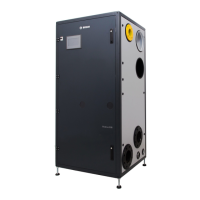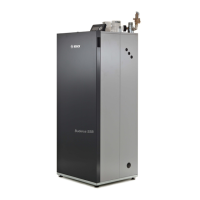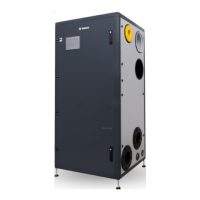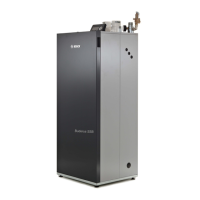SSB 6720866942 (2018/06) US
Installation | 15
4.2.3 Boiler location
• This boiler is suitable for indoor installations.
• To operate properly and safely this boiler requires a continuous supply
of air for combustion. Install this boiler in a clean, dry location with
adequate air supply.
• Do not locate this boiler in an area where it will be subject to freezing.
• The boiler should be located close to a oor drain in an area where
leakage from the appliance or connections will not result in damage to
the adjacent area or to lower oors in the structure.
• DO NOT install this appliance in any location where gasoline or
ammable vapors are likely to be present.
• DO NOT install this appliance on top of carpet ooring.
• Appliance must be installed on a level oor.
• Maintain required clearances from combustible surfaces.
4.3 Water chemistry guidelines
Excessive water hardness causing a lime buildup in the stainless steel
coils or tubes is not a fault of the appliance and is not covered by
warranty. Water hardness must fall within the following limits:
Parameters Units Value
General feature - Colorless, no sediment
PH value PH Min 6.5; Max 9
Dissolved Oxygen mg/l < 0,05
Total iron (Fe) mg/l < 0,3
Total copper (Cu) mg/l < 0,1
Na
2SO3 mg/l < 10
N
2H4 mg/l < 3
PO
4 mg/l < 15
CaCO
3 ppm Min 50 ; Max 150
Trisodium Phosphate ppm absent
Chlorine ppm < 100
Pressure PSI Min 7.25; Max 80
Glycol % Max 40% (only propylene glycol)
• Before and during assembly, the system must be kept free of
impurities, construction dust, sand, copper dust, grease, carbon
deposits as well as welding ux residue.
• Before connecting the boiler to the heating system, ush the heating
system to remove sediment, ux, dirt, and other foreign matter.
• Do not use cleaning uids that are not compatible with the boiler
materials, including acids (e.g. hydrochloric acid and similar ones) at
any concentration.
• Introducing fresh water to the system increases the oxygen presence
and can cause corrosion of metallic components. Immediately repair
any drips or leaks in the system to avoid constant introduction of air
into the system.
• Excessive uctuation in pressure changes in the system can cause
fatigue and stress on the heat exchanger. This is detrimental to the
integrity of the boiler and system components, it is mandatory to
maintain a constant operating pressure.
• Avoid an automatic water ll system.
• Use only untreated water to ll the system.
• Do not use TSP (tri-sodium phosphate)
• Do not use ll water treated with salt bedding type exchangers (ion
exchanger).
• Consult a local water treatment specialist for recommendations if any
of the above table is outside the stated ranges.
• When using oxygen permeable PEX, the system must be separated
from the boiler by a heat exchanger.
• A correctly sized and working expansion vessel must be installed.
• Excessive ow can cause erosion damage to the heat exchanger.
CAUTION: For freeze protection use only propylene
glycol, with scale inhibitors, with a maximum volume
[concentration] of 40% of glycol. Frost protection and
inhibitor level has to be checked annually during the regular
scheduled maintenance of the condensing boiler.
CAUTION: The boiler, when used in connection with
a refrigeration system, must be installed so the chilled
medium is piped in parallel with the boiler with appropriate
valves to prevent the chilled medium from entering the
boiler.
CAUTION: The boiler piping system of a hot water boiler
connected to heating coils located in air handling units
where they may be exposed to refrigerated air circulation
must be equipped with ow control valves or other
automatic means to prevent gravity circulation of the boiler
water during the cooling cycle. A minimum water pressure is
required for optimum performance. Minimum water pressure
required: 7.25 psi (0.5 bar).
4.4 Hydraulic connection
The SSB Boiler utilizes 3” anges for models SSB 800 SA/ 1000 SA and
5” anges for model SSB 1000 TL for the water system supply and return
piping connections. The physical location of the supply and return piping
connections is on the side of the unit as shown in Fig. 12 - Fig. 13.
6” PP Flue Venting
6” Air Intake
1”1/2 Condensate outlet
2” Relief valves outlet
Fig. 12 SSB 800 SA and 1000 SA Connections

